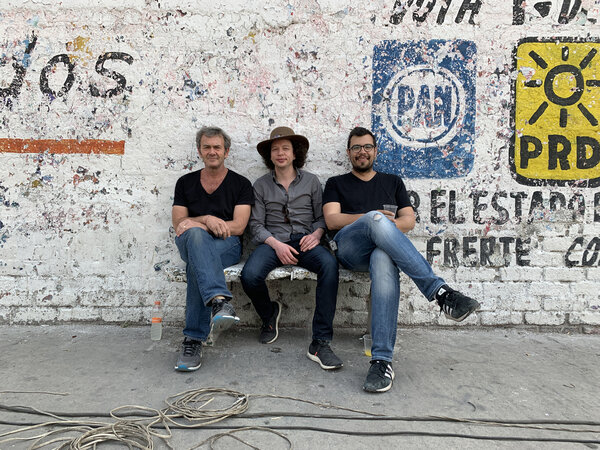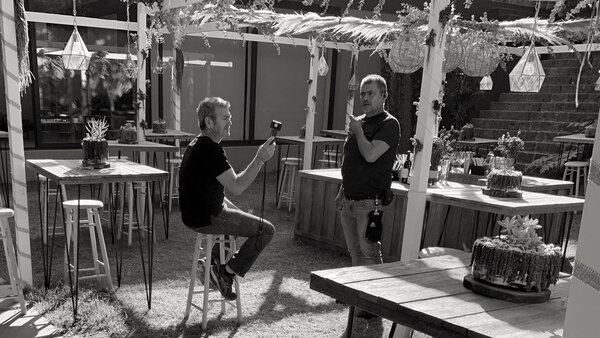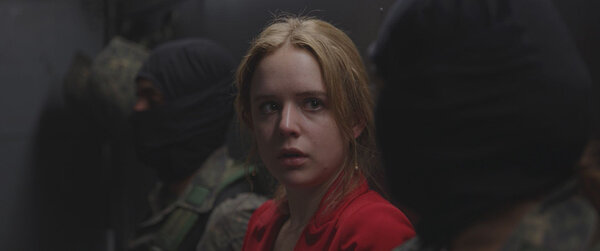Interview with Yves Cape, AFC, SBC, about "New Order", by Michel Franco, selected at the 2020 Venice Film Festival
How do you prepare a film like this ?
Yves Cape : Each film I’ve done with Michel Franco has had a fairly long prep period. Since he’s also the screenwriter, I usually get the first draft a year before filming, followed by a new one about every two months. Drafts that evolve as the preparation and our discussions progress. Michel is a real cinephile, that allows him to feed us a lot of film references, not only for the visuals but also for the general atmosphere or the style of storytelling. He’s also above all someone who likes collaboration, like all the great directors with whom I have been able to shoot. He feeds on the suggestions of his close collaborators and does not hesitate sometimes to integrate those ideas into the writing or filming process… By being the producer as well, he’s free to budget for whatever the film needs.
In the case of New Order, for example, it was shot in almost chronological order, with the exception of some sets, such as the hospital, for which there was no other option than to shoot everything at once. By ensuring the availability of all of the actors during the length of the shoot, he crafts the film as we go along, editing the film while shooting.

So this means that the editor is on set with you ?
YC : Yes, the editor is physically close to the set. As soon as we’ve finished a scene, the cards are offloaded and logged to be uploaded into the editing suite. A DIT color corrects the images and Michel examines what works and what doesn’t. I know that he even organizes during the shoot, after about two weeks, the first test screenings of the film in progress to some friends to find out how they react to it. It is of course a radically different approach to filmmaking compared to other directors who refuse to even review the rushes, and who entrust this work entirely to the editor… On this shoot, as on the previous ones, we are all moving forward step by step, not without having prepared beforehand, but by testing certain solutions, even if it means starting over again if the result is not satisfactory.
What were his references for this film ?
YC : Among the references, he told me about was Salò, or the 120 Days of Sodom, by Pasolini. Not for the images as such, but more for the way of depicting violence, torture, and sexual humiliation he wanted to approach for the scenes set in the detention center. We chose to build this set in a series of industrial hangars converted into studios in Mexico City. This way we were able to shoot a lot of scenes and sets with total freedom or to reshoot them, day or night, all while following the order of the script. This way we modified some scenes depending on the feedback from the editing room. An example is the end of the film, with the scene where the bodies are on fire. A fairly wide, sequence shot, the post-production of which was entrusted to Mikros to merge the beginning shot with the extras and the end by replacing them with mannequins set on fire…

What about the image format ?
YC : From the start during prep Michel asked me to shoot the film in 2.4:1 and handheld, to evoke the chaos. He’s an avid user of the sequence shot, with little or no camera movement – except for a few shots in cars or for the film Les Filles d’Avril on which a few dolly shots by the sea were allowed. I was not necessarily convinced of this choice. Finally, as the film became clearer in our heads, we decided to start handheld for the scenes at the wedding and then have a more stable camera when things get out of control for the protagonists… sort of a visual counterpoint to the chaos that takes hold in the story. Nevertheless, we decided to shoot everything on a dolly, while handholding the camera, which gives it an organic feel while still maintaining certain invisibility to the shots. To dose things exactly, I shot 10% wider on a camera whose 5K sensor is basically very sharp, allowing myself in post-production to do some stabilization. This film was a new departure for Michel Franco in terms of blocking the camera because it was the first time where he allowed himself to do shot and reverse shot and also used much more editing, especially in this first part of the film set in the bourgeois house.
So you didn’t have precise shot lists then ?
YC : No. Strictly speaking, there are no rules on Michel’s films. We mainly determine the movements of actors in relation to the script and we integrate them into the set. Then it is by feeling that it happens. If we take the example of the opening scene at the wedding party, it took us two weeks to shoot facing a lot of challenges. The original idea was to treat it as a dance and go from one character to another to introduce them in the story while respecting the rather complex storytelling needs. For example, dealing with that scene where the domestic worker comes to ask for money to cover his wife’s care in the hospital. A situation set apart in a party that is in full swing… How to position the character so that he can both be in the space, close to the festivities and at the same time a little isolated in his encounters with each member of the family ? It is an important scene because it is also what will decide the bride to briefly leave the reception to go to draw money from a distributor accompanied by one of the serva… Here too, the editor very quickly advised us to ellipse her journey in order to avoid seeing her pass in front of the guests before her departure in the middle of the party … Another difficulty, in the second part of the party, the sudden appearance of the demonstrators. It was filmed in a very frontal manner and the dosage of the violence was not obvious, between in-camera effects, visual effects, and stunts. This was also a situation where the possibility of editing on the set allows you to know quite precisely what works and what does not… A novelty in the filmmaking language of Michel, who had previously emphasized the length of each shot and a certain restraint in editing.

What about your choice of equipment ?
YC : Personally, I like the simple things when it comes to camera equipment. Also, I remain nostalgic for the days shooting on film, with a well-balanced Aaton, an optical viewfinder, and excellent user-friendliness. My choice is mainly towards a camera that allows me – even if I only use 10 or 15% of its technical possibilities – to end up with the cleanest and most natural-looking image possible. And having a good viewfinder, although none of them satisfy me perfectly I can still interpret what I see. This is also why I am not a fan of vintage optics and their handling of flares, their difficulty to obtain a particular focal length, matters which only complicate things afterward in the grading… For this film, I chose the Leitz Summilux lenses. In a way, I chose a discreet and efficient camera and lens package.
Let’s talk about the second part of the film, after the party…
YC : Everything else in the movie was shot in four weeks. The scenes set in the neighborhood during the riots required a lot of preparation, both in terms of extras and set decoration, but also for visual effects. We have, for example, done crowd duplication in the cemetery scene, by having shot in five passes with vertical divisions, composited in post by Mikros. Michel is very fond of these kinds of invisible visual effects and encourages me to handle them for him. I must admit that my knowledge of the process is sufficient to take care of everything myself without the presence of a supervisor on the set after having had a few phone calls in preparation so as not to make mistakes. On this more nocturnal scene, a lot of things were created through lighting as well, by deliberately isolating the people from the background to reinforce the feeling of being "cut off" from the world.
The movie has a bit of a prophetic side to the events that have unfolded since, right ?
YC : The film was shot in Mexico during the French yellow vests crisis, we drew a lot of inspiration from those Parisian images for the riot scenes. Also important for us was a book with a collection of photos called Urban Pulses, Latin America in motion, on the many local revolutions. Moreover, in our first discussions, Michel told me of his desire to make a film on the Mexican Revolution transcribed today. The film was then caught up by the news, with the lockdown and especially the "black lives matter" movement that is emerging in the USA. Since then, the situation has been quite tense in Mexico with the emergence of the first hate hashtags between the white communities and indigenous South Americans. During the lockdown, all of Mexico City’s upscale neighborhoods were closed and protected by walls.
A word about Marianne, the bride… How did you manage her long descent into hell from the point of view of her character ?
YC : It was a long process that started with the costume design. In fact, she was originally supposed to be dressed in a more classic wedding dress. But I never imagined for a second lugging this character around in the middle of what she’s going to endure in a wedding dress… it would have almost become comical…


We exchanged a lot of ideas for the fabric of her dress and at one point I suggested using the color red. The result was a slightly modern costume, with a very precise ruby tone that could still match the very pale complexion of the actress, Naian Gonzalez, and her blond Venetian hair. While also working on her hairstyle, we decided to only make up her eyes, in the beginning, and to keep her natural hair color, to gradually evolve towards a face without makeup and marked by fatigue and the violence that she undergoes. Among the tricks used, we slightly desaturated her skin tone over time, with the help of the DIT, while working with the makeup artist. The result is quite effective while remaining natural.
(Interview by François Reumont, translated from French by Anton Mertens, SBC, on behalf of the AFC)
 En
En Fr
Fr




